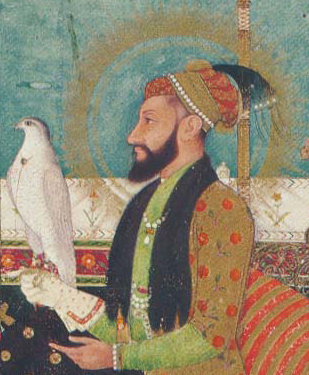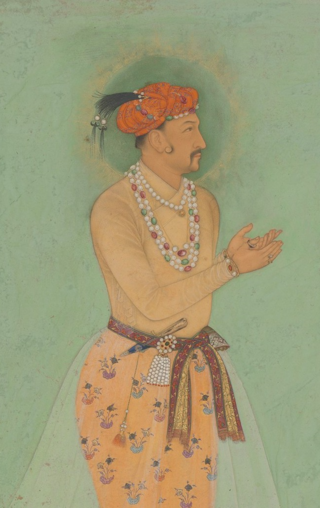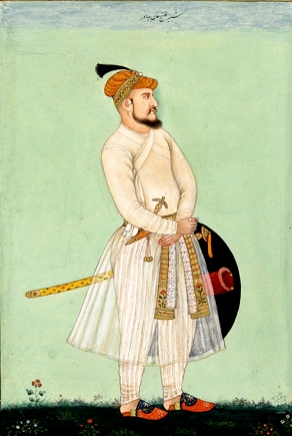
Muhi al-Din Muhammad, commonly known as Aurangzeb, was the sixth Mughal emperor, reigning from 1658 until his death in 1707. His regnal name is Alamgir I, which derived from his title, Abu al-Muzaffar Muhi-ad-Din Muhammad Bahadur Alamgir Aurangzeb Badshah al-Ghazi. Under his emperorship, Mughal India reached its greatest extent with territory spanning nearly the entirety of the Indian subcontinent.

Nur-ud-Din Muhammad Salim, known by his imperial name Jahangir, was the fourth Mughal Emperor, who ruled from 1605 till his death in 1627.

Mirza Shahab-ud-Din Muhammad Khurram, also known as Shah Jahan I, was the fifth Mughal emperor, reigning from 1628 until 1658. During his reign, the Mughals reached the peak of their architectural and cultural achievements.

Shah is a royal title that was historically used by the leading figures of Iranian monarchies. It was also used by a variety of Persianate societies, such as the Ottoman Empire, the Kazakh Khanate, the Khanate of Bukhara, the Emirate of Bukhara, the Mughal Empire, the Bengal Sultanate, historical Afghan dynasties, and among Gurkhas. Rather than regarding himself as simply a king of the concurrent dynasty, each Iranian ruler regarded himself as the Shahanshah or Padishah in the sense of a continuation of the original Persian Empire.

Mirza Mu'izz-ud-Din Beg Muhammad Khan, better known by his title Jahandar Shah, was briefly the ninth Mughal emperor from 1712 to 1713. He was the son of emperor Bahadur Shah I, and the grandson of emperor Aurangzeb.

Jahanara Begum was a princess of the Mughal Empire. She was the second and the eldest surviving child of Mughal Emperor Shah Jahan and Mumtaz Mahal.
Nawab, also spelled Nawaab, Navaab, Navab, Nowab, Nabob, Nawaabshah, Nawabshah or Nobab, is a royal title indicating a sovereign ruler, often of a South Asian state, in many ways comparable to the western title of Prince. The relationship of a Nawab to the Emperor of India has been compared to that of the Kings of Saxony to the German Emperor. In earlier times the title was ratified and bestowed by the reigning Mughal emperor to semi-autonomous Muslim rulers of subdivisions or princely states in the Indian subcontinent loyal to the Mughal Empire, for example the Nawabs of Bengal.
Padishah, sometimes romanised as padeshah, patshah, padshah or badshah, is a superlative sovereign title of Persian origin.
Shahanshah is a title given to the Iranian Shahs (kings/emperors), meaning King of Kings.
Mirza is a name of Persian origin. It is used as a surname or prefix to identify patriarchal lineage. It is derived from the term Mirzadeh (میرزادہ).

Shah Jahan II, born Mirza Rafi-ud-Daulah, was briefly the twelfth Mughal emperor in 1719.

ʿAbd-al-Ḥamīd Lāhūrī was a 17th-century traveller and historian during the reign of Mughal Emperor Shah Jahān who later became a court historian for the emperor. He wrote the Pādshāh-nāma, the official chronicle of the Shah Jahān's reign. He has described Shah Jahān's life and activities during the first twenty years of his reign in this book in great detail. Infirmities of old age prevented him from proceeding with the third decade, which was later chronicled by Muḥammad Wārith, his pupil.

Muhammad Saleh Kamboh Lahori was a noted Punjabi Muslim calligraphist and official biographer of Emperor Shah Jahan and the teacher of Mughal Emperor Aurangzeb. Though a widely read person, little is known of the life of Muhammad Saleh Kamboh other than the works he composed. He was son of Mir Abdu-lla, Mushkin Kalam, whose title shows him to also have been a fine writer. He is believed to be younger brother of Inayat-Allah Kamboh and worked as a Shahi Dewan (Minister) with the governor of Lahore. He held the title of Sipahsalar.

Narnala Fort or Narnala Qila Sarkar, also known as Shahnoor Fort, is a hill fortress in the Satpura Range of Vidarbh, Maharashtra, India, named after the Rajput Solanki Chaulukya Ruler, Raja Narnal Singh, also known as Narnal Singh Swami. It was renamed as "Shahnoor" by Islamic rulers but again acquired, rebuilt and got its name "Narnala" by ruler Rao Rana Narnal Singh Solanki, who migrated from Patan in Gujarat.

Khawaja Abid Khan Siddiqi, or Nawab Khawaja Abid Siddiqi, better known as Kilich Khan, was a Nawab and military general under Mughal Emperor Aurangzeb. He was a loyal general of the Mughal Empire. He was the father of the Mughal general Ghazi ud-Din Khan Feroze Jung I and the grandfather of Mir Qamar-ud-din Siddiqi, Asaf Jah I. Kilich Khan was a descendant of Abu Bakr, first Rashidun caliph.
Ispahsālār or sipahsālār, in Arabic rendered as isfahsalār (إسفهسلار) or iṣbahsalār (إصبهسلار), was a title used in much of the Islamic world during the 10th–15th centuries, to denote the senior-most military commanders, but also as a generic general officer rank.

Mirza Sipihr Shikoh also known as Sipihr Shukoh, was a Mughal prince as the fourth son of Crown Prince Dara Shikoh and his consort Nadira Banu Begum.

Sahib Jamal was the wife of Prince Salim, the future Mughal emperor Jahangir and the mother of his second son, Prince Parviz.

Padshah Begum was a superlative imperial title conferred upon the empress consort or 'First Lady' of the Mughal Empire and was considered to be the most important title in the Mughal harem or zenana. This title can be equivalent with "empress" in English, but in only approximate terms in the Mughal context.
Miangul Abdul Wadud was the Wāli of Swat from 1926 until his abdication in 1949. A grandson of the Akhund of Swat, he was elected as ruler of Swat by a loya jirga in November 1918 and was formally recognized as Wāli of Swat on 3 May 1926 by the British authorities. He ruled from 1918 to 1949, when he abdicated in favour of his eldest son, Miangul Jahan Zeb.












